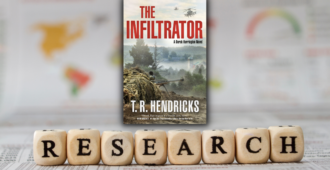Written by Brian Staveley
There’s a scene near the middle of The Emperor’s Blades in which a class of Kettral cadets, ultra-elite warriors who fly massive hawks into battle, are undergoing their final test: Hull’s Trial. People who have read the book ask about this scene a lot, and about Kettral training more generally. They want to know if I’ve served in the military – I haven’t – and then they want to know where in the hell all the training material comes from. The answer (aside from lots and lots of reading about military training) is adventure racing.
It’s an obscure sport, unknown to most people – a cross between orienteering, triathlon, and monastic penance. Teams (you compete with two or three other people, staying with them throughout the entire race) are handed a topographical map (or maps) at the starting line. Formats vary, but the goal is always essentially the same: find as many points as you can. Races vary from six hours to six days, and disciplines include trail running, mountain-biking, canoeing, rafting, nordic skiing, snowshoeing, and wading hip-deep through chilly swamps in the middle of the night with your pack above your head wishing you hadn’t eaten the last banana four hours earlier.
My wife has asked me many times why I enjoy these races, and the answer pretty much boils down to one thing: unpredictability. If I go out to run a 10K, I know what to expect. I can guess my time to within a minute. I know more or less who will beat me and who won’t. None of this certainty applies in the world of adventure racing.
The very first leg of my very first race involved paddling a massively storm-swollen river in northern Vermont. About an hour in, we hit a tricky little stretch of rapids, and our canoe capsized, then sank. So did the canoes of almost every other team. Dozens of people were pinned up against the bridge pilings by the current or running around both banks of the river, some trying to find teammates, others searching desperately for canoes and paddles, packs and maps. I remember hauling myself out of the water, finally, to find the race director laughing on the bank. Novice that I was, I assumed the whole thing was over. I asked what we should do. “Do?” he repeated, staring. “Do? It’s a race, isn’t it? Keep racing!”
That’s when I realized we needed a different training program. We kept up with the running and the biking, but we added new elements. One year, we all kept loaded backpacks by our beds. Once a month, you could call anyone on the team at any time and tell them to put on the pack and go run for an hour. Most calls happened late at night, usually in rain, snow, and high wind. We ran a lot of stadiums, which was good exercise, but sometimes we just carried our bikes around in the woods all night long, which was good exercise of a different sort. In a sport where thirty percent of the teams drop out of every race, emotional fitness becomes as important as physical fitness. In fact, it gives middle-aged, baby-raising, injury-plagued folks like me a chance against the hot shots with their spandex and carbon fiber bikes.
Not to say that I’d make it one week with the Kettral. As I said, I’m not a military guy. But, the scenes when they’re paddling boats with their hands or dragging around barrels filled with wet sand – well, all that sounds unpleasantly familiar.
…………………………
From the Tor/Forge January 6th newsletter. Sign up to receive our newsletter via email.
…………………………
More from the January 6th Tor/Forge newsletter:
- Books: I Like Them, Who Could Have Guessed? by Jo Walton
- Building Ilmatar by James Cambias
- January Grab Bag Sweepstakes








That is pretty much the most awesome thing I’m going to hear all week. Also, I’m ordering this book //right now//.
Yes, this just convinced me to read the book and look into adventure racing too…
Thank you so much for sharing that, it explains a lot. Hull’s Trial was brilliant. Great read!
Wading through chilly swamps with a pack above my head sounds a lot like the military to me… I was a canine handler. Mainly handled tracking dogs. We used to say it wasn’t a proper track unless we were out over 8 hours and had at least two swamps, a high cliff, a booby trap, some generally impossible terrain and bad weather, complete darkness, and a nice little ambush to end it.
Then I returned to civilian life and trained dogs with civilians and my jaw dropped upon hearing that a civilian “elite track” is just 1,5 km, and common practice is to complain to the judges if your track contains too many sharp turns or too rough terrain that makes it difficult for the handler. Aaand for night tracks they use headlamps, if they do them at all.
In my military time, the very best training exceeded the physical and emotional demands of actual combat. When combat seemed somewhat routine (other than what Murphy could dream up for you), then you were trained.
I have raced the GMARA Bitter Pill the past four years (it’s how I got to this post) and understand what your talking about! I’m also an avid Fantasy reader. Can’t wait to pick up your book and give it a read!